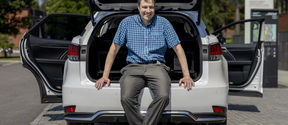Invisible powers are driving cars and cranes, but what goes on behind the scenes to get these machines moving?
What gets autonomous cars and industrial robots going?

FALSE. Elon Musk and traditional automakers have claimed self-driving cars would be on the roads in the early 2020s, but Tammi says that, like many other technology predictions, it’s ‘at least 10 years away’. We might see self-driving cars in the 2030s or 40s; currently, only Mercedes can drive autonomously on limited roads or speed zones in Germany and some US states. These cars still need to be driven to and from those locations by a human driver.
Tammi thinks this could be TRUE in defined locations, like truck or bus terminals, where vehicles could load and unload or even go through a carwash autonomously. But on Finland’s snowy roads: definitely FALSE.
FALSE. This kind of tech won’t be accepted or pass tests if it’s dangerous, says Tammi. The crashes and few fatal accidents that have occurred have been caused by human misuse, not the tech itself; for example, driver assistance features were used incorrectly, or the human driver wasn’t in their seat or had passed out. These are flagrant traffic safety violations whether they occur in a normal or autonomous vehicle.
Technology cannot guarantee that autonomous driving will be completely safe. Before self-driving cars become widely accepted, they’ll have to cause many fewer accidents than humans do—but the accident rate will never be zero. Car companies already have to show that features like cruise control or lane assistance increase safety, and the same will have to be done for technologies that go beyond driver assistance towards autonomous driving.
But hacking is a big risk that hasn’t yet been seriously considered or tackled. Vehicle software can be hacked, and malicious actors could upload broken software that would cause crashes or disrupt the car’s sensors. In simple cases, the car itself can detect the fault, but serious hacking could stop a car from knowing it had been tampered with.
Tammi wants to say this is TRUE, but then he considers the case of his own family. With an autonomous car, two adults and two children could each travel separately to school and work. Even if vehicles are smart about route planning, problems can come from users being lazy, says Tammi. In this example, there would be more trips, which shows how autonomous vehicles could increase traffic. Consider a taxi versus a bus: taxis are always empty going in one direction. If an autonomous urban taxi fleet could operate more like buses, that could be an efficient traffic solution—as long as people aren’t in the loop messing with the decisions.
TRUE, says Tammi. Cities are much more predictable environments, at least for now. The Finnish countryside has lots of bumpy gravel roads, not to mention snow covering the roads. Self-driving cars need controlled conditions to operate safely, but they could probably drive outside of cities on defined interstate or national roads, similar to a train.
TRUE, in the far future. Society may decide that traffic deaths or traffic rule violations become unacceptable, and people will no longer be permitted to drive. But Tammi emphasizes the long timeframe. In this scenario, children, senior citizens or blind people would be able to ‘drive’ themselves, since driving licenses would be obsolete and people wouldn’t have to understand traffic rules. In this respect, autonomous driving could be a real win for equality and accessibility; people who currently can’t drive would be able to. On the other hand, says Tammi, we also have to consider traffic poverty. For example, electric cars are currently expensive and so don’t contribute to equality in reducing emissions. Part of the challenge is to ensure that autonomous vehicles don’t remain the privilege of the wealthy.

What gets autonomous cars and industrial robots going?

'Aalto is a pretty calm and safe environment to work in. The management and evaluation system is relatively kind, and the rules are just right for an odd and absent-minded person like me.'

This white car may look like a regular SUV, but a closer examination reveals a laser scanner on its roof. Inside, it’s missing a gear stick, as A!ex shifts gears with the aid of an algorithm.

